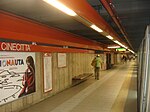Capannelle Racecourse

Capannelle Racecourse (Italian: Ippodromo delle Capannelle) is a horse racing venue in Rome, Italy. The course was constructed in 1881, and it was rebuilt in 1926 to a design by Paolo Vietti-Violi. It was recently the venue of two Group 1 flat races – the Premio Lydia Tesio (downgraded to Group 2 in 2019) and the Premio Roma (downgraded to Group 2 in 2017). The track also stages the most valuable flat race in Italy, the Derby Italiano, which was downgraded to Group 2 status in 2009. Group 2 races include the Premio Ribot and the Premio Presidente della Repubblica. Group 3 races include the Premio Tudini, Premio Carlo Chiesa, Premio Carlo e Francesco Aloisi, Premio Carlo d'Alessio, and Premio Guido Berardelli. It is also home ground of Italy's premier cricket club, Capannelle Roma. On September 8, 2019, the world's largest pizza party was held at the racecourse, where 1,146 people dined on pizza together.
Excerpt from the Wikipedia article Capannelle Racecourse (License: CC BY-SA 3.0, Authors, Images).Capannelle Racecourse
Via delle Capannelle, Rome Municipio Roma VII
Geographical coordinates (GPS) Address Nearby Places Show on map
Geographical coordinates (GPS)
| Latitude | Longitude |
|---|---|
| N 41.823611111111 ° | E 12.569166666667 ° |
Address
Via delle Capannelle
00178 Rome, Municipio Roma VII
Lazio, Italy
Open on Google Maps








